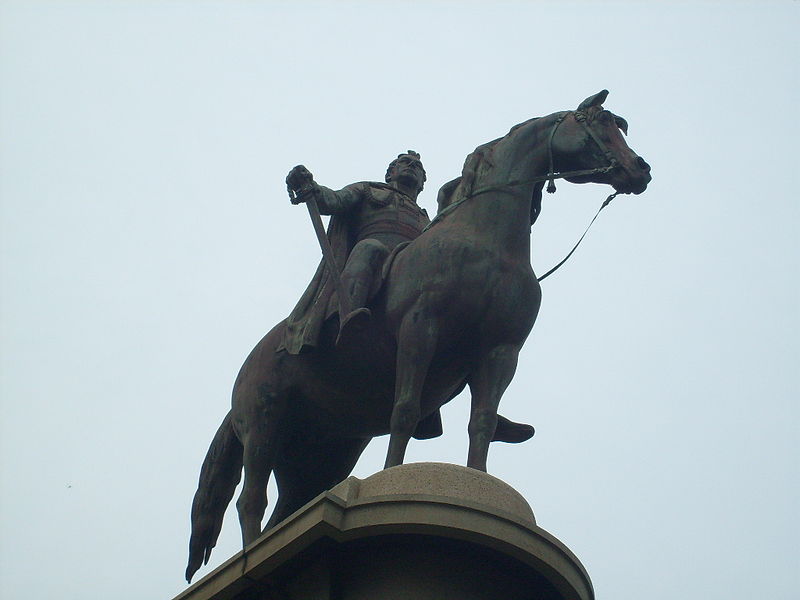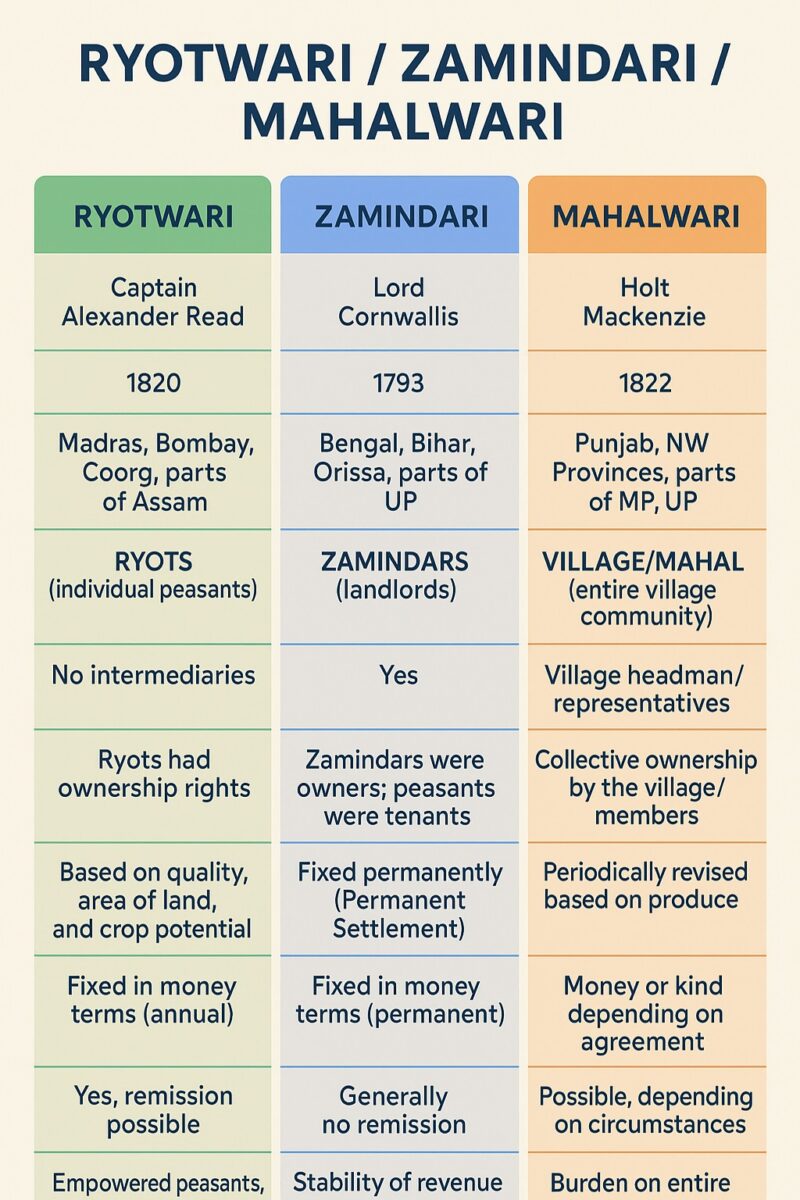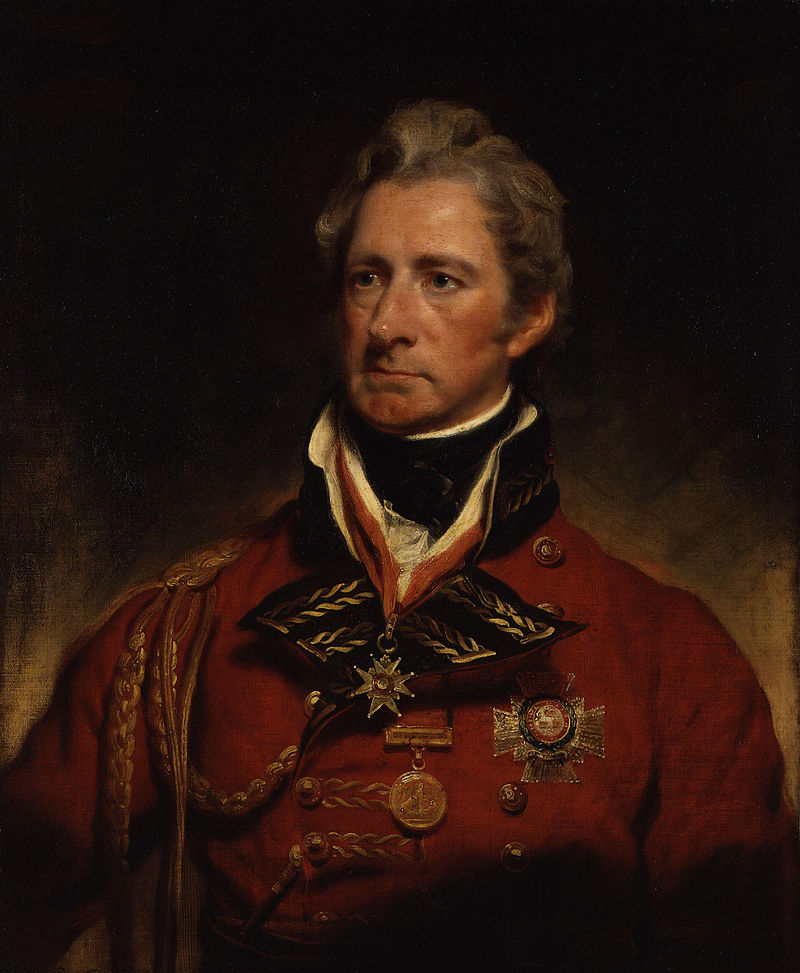Ryotwari settlement in land law
The Ryotwari System in land law (also called Rayotwari System or Raiyatwari Vyavastha) was a land revenue system in India during the British Raj. It was first devised by Captain Alexander Read and later developed to its full form by Sir Thomas Munro. The Ryotwari System’s year of introduction is generally taken as 1820 when Munro implemented it extensively as the Governor of Madras. This system is particularly important for UPSC preparation (ryotwari system UPSC) as it was one of the three main revenue systems in British India, alongside the Zamindari System and the Mahalwari System.
The ryotwari system in India was primarily used in the Madras Presidency, the Bombay Presidency, Coorg, and parts of Assam. The word “Ryot” (also called raiyat or rayat) refers to the individual peasant cultivator.

What is the Ryotwari System?
It was a system where the British government collected land revenue directly from the ryots (peasants) without intermediaries like zamindars. The ryotwari settlement system gave peasants legal ownership of the land, provided they paid the fixed revenue to the state.
The ryotwari system was introduced in the Madras Presidency first, and the year of introduction was 1820. In Hindi, it is often referred to as “Raiyatwari Vyavastha kya hai” for competitive exams.
Who introduced the Ryotwari settlement?
The person who devised the Ryotwari settlement in land law – Captain Alexander Read (Alexander Read UPSC fact). Who started the Ryotwari System? Sir Thomas Munro developed and expanded it between 1820–1827 (Thomas Munro Ryotwari System).
The Ryotwari System was first implemented in: Baramahal district under the Alexander Read. The Ryotwari System was introduced in which state? Initially in Tamil Nadu (Madras Presidency).
Main Features of the Ryotwari Settlement in Land Law
The Ryotwari Settlement UPSC notes should include these points:
- Ownership of Land – Every registered ryot was recognised as the owner of his land. (Ryotwari System founder – Thomas Munro).
- Direct Payment – Revenue was paid directly to the government.
- Freedom of Transfer – The ryot could sell, gift, mortgage, or lease the land.
- Security of Tenure – The ryot could not be evicted as long as revenue was paid.
- Annual Choice – The ryot could expand, reduce, or abandon land annually.
- Revenue Assessment – Fixed in money terms, not in kind; remission possible in case of crop failure.
- No Intermediaries – Unlike the Zamindari System, there were no middlemen.

Ryotwari System vs. Mahalwari System
While the Mahalwari System was introduced by Holt Mackenzie and Robert Merttins Bird (mainly in North-Western Provinces), the Ryotwari System focused on individual peasants rather than villages.
Ryotwari System UPSC Quick Facts
- Ryotwari System was also known as: Munro System, Rayotwari System, Raiyatwari System.
- Ryotwari System introduction year: 1820 (Ryotwari System 1820).
- The Ryotwari System was introduced by Captain Alexander Read, developed by Thomas Munro (Thomas Munro UPSC).
- Ryotwari Settlement was introduced in Madras, later Bombay, Coorg, and Assam.
- The Ryotwari land revenue system was first launched in which presidency? Madras Presidency.
- When was the Munro System introduced? 1820–1827.
- English meaning: Direct settlement between the state and the peasant.
- Who are ryots? Individual cultivators or peasants.
- The Thomas Munro statue in Chennai still commemorates his role in implementing this system.
Ryotwari settlement in land law features compared with the Zamindari, Mahalwari Systems
| Feature / System | Ryotwari System | Zamindari System | Mahalwari System |
|---|---|---|---|
| Introduced By | Devised by Captain Alexander Read, developed by Sir Thomas Munro | Lord Cornwallis (Permanent Settlement, 1793) | Holt Mackenzie (1822) and Robert Merttins Bird (1833) |
| Year of Introduction | 1820 (Madras Presidency) | 1793 (Bengal Presidency) | 1822 (North-Western Provinces) |
| Areas Implemented | Madras, Bombay, Coorg, parts of Assam | Bengal, Bihar, Orissa, parts of UP | Punjab, NW Provinces, parts of MP and UP |
| Revenue Collected From | Ryots (individual peasants) | Zamindars (landlords) | Village/Mahal (entire village community) |
| Role of Intermediaries | No intermediaries – direct contact with cultivators | Yes – Zamindars collected and paid revenue to the British | Periodically revised based on production |
| Ownership of Land | Ryots had ownership rights | Zamindars were owners; peasants were tenants | Collective ownership by the village/members |
| Assessment Basis | Based on quality, area of land, and crop potential | Fixed permanently (Permanent Settlement) | Yes, remission is possible |
| Payment Mode | Fixed in money terms (annual) | Fixed in money terms (permanent) | Money or kind, depending on the agreement |
| Remission in Bad Seasons | Stability of revenue for the British | Generally no remission | Possible, depending on circumstances |
| Advantage | Empowered peasants, flexible holding | Village headmen/representatives dealt with the British | Balanced community responsibility |
| Disadvantage | Heavy burden if crops failed | Exploitation by zamindars | Burden on the entire village if the crop failed |
| UPSC Tip | Remember Ryotwari → Ryot = Peasant | Zamindari → Zamindar = Landlord | Village headman/representatives dealt with the British |
Conclusion
The Ryotwari Settlement in land law was a major shift from the Zamindari System, empowering ryots with land ownership but also binding them to fixed monetary revenue demands. For UPSC, it is crucial to remember who introduced this System in India (Alexander Read, developed by Thomas Munro), where it was introduced first (Madras Presidency), and the Ryotwari System year (1820).
FAQ
- The Ryotwari system was introduced by?
The Ryotwari system was devised by Capt. Alexander Read and later by Sir Thomas Munro at the end of the 18th century. Then-Governor of Madras Sir Thomas Munro, during 1820-1827, introduced the Ryotwari system to its full effect. This was the main revenue system in South India that included Madras, Bombay, Coorg and also in parts of Assam.
